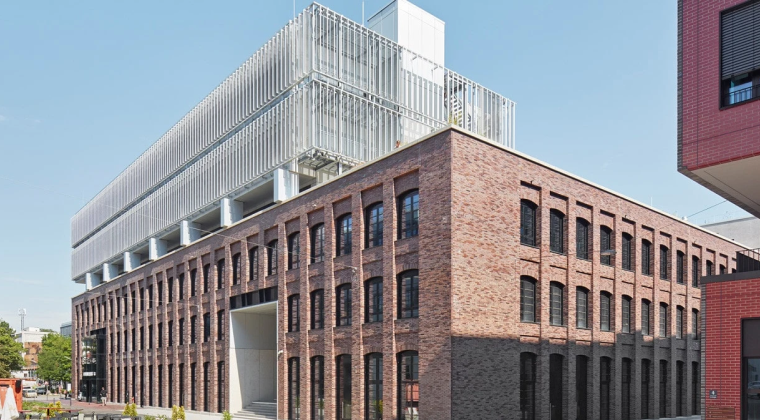
White Arkitekter Finds a Technology Partner That Grows with It
With Egnyte, the design firm modernized its IT infrastructure – and formed a relationship that has guided it through moments of major change.
How Egnyte benefits White Arkitekter
- Helped build replicable, project-specific collaboration environments accessible from anywhere
- Eased the pandemic-era shift to remote work
- Broke down barriers in collaboration with external partners

White Arkitekter is a Swedish architecture firm headquartered in Göteborg with nine offices across Sweden, as well as one in Germany and the UK. In 2017, the firm was looking to modernize its technology infrastructure. After trying multiple solutions, the firm ultimately landed on Egnyte, owing largely to Egnyte’s file sharing functionality, security and compliance posture, and proven ability to stay on the cutting edge of product and feature development.
Since then, White and Egnyte have been by each other’s side through workflow changes, feature enhancements, and a global pandemic.
Challenge: Modernize an Aging IT Environment
Prior to Egnyte, White used local file servers in combination with tools such as Dropbox, WeTransfer and Cryptshare for file sharing. Across a team of roughly 800 users, the feedback was nearly unanimous: The user experience that these tools offered left much to be desired. It created what Systems Administrator Fredrik Persson calls a “shadow IT” environment, in which “people took the liberty of using other products that worked better, which created a huge mess – we had no continuity in the systems people were using.”
Nowhere was the user experience problem more apparent than in situations requiring external collaboration. Persson offers an anecdote: “When we wanted to collaborate or share something with external partners, we had to get a computer set up for our interface and workflow and actually mail the computer to that person.”
The team knew something needed to change. They began a process of interrogating all the products in their technology stack in search of opportunities to modernize.

Solution: Collaboration and Project Management through Egnyte
The team brought in a set of file sharing and collaboration tools for a comprehensive vendor selection process. They started with Dropbox, Citrix ShareFile, Egnyte, and several others. Eventually, all of these were dismissed except for ShareFile and Egnyte. “We decided to stress test these two systems against each other,” Persson explains. “We set up different scenarios and brought in different people to try them out. Eventually, we went with Egnyte.”
Though they may not have known it at the time, this was the start of a partnership that has been steadily delivering more and more benefits to White Arkitekter for eight years and counting. The longevity of this relationship owes largely to the ease of internal and external collaboration in Egnyte compared to ShareFile, Dropbox, or the firm’s previous on-prem infrastructure. For example, instead of literally mailing a physical computer to external collaborators, the team can “share files via secure links or even invite them into our centralized Egnyte domain so they can access files themselves,” as Arvid Vessman, Service Owner, Digital Workplace at White Arkitekter, puts it.
White also leveraged Egnyte in the creation of what the firm calls “White Spaces.” These are project-specific web interfaces integrated with an arsenal of critical apps – including Egnyte, Slack, Microsoft tools, and more – that White creates as a storage and collaboration environment for each project. Egnyte’s role in facilitating White Spaces was monumental. “With Egnyte, we can set up an intuitive folder structure that we can then deploy across our White Spaces, so that each project has its own predefined structure,” says Vessman. “This gives us a head start; we don’t have to recreate the wheel each time we create a White Space. That makes things really easy for our users, which has been a big win in our adoption rate.”
When Covid-19 arrived, many companies experienced tremendous disruption, as teams were suddenly dispersed away from the office and into their homes. But Egnyte’s remote file sharing and granular permissions functionality enabled White to continue working on critical content without interruption. As Vessman says, “Egnyte’s cloud infrastructure makes it easily accessible from anywhere with an internet connection, which meant our users could still get into their White Spaces and keep working after Covid-19 sent them home. The platform also lets us see where each file lies and set permissions governing which files can be shared externally. That prevents any improper sharing even when people are using their home computers miles away from our IT team.”

Benefits: The Technology Partnership of White Arkitekter’s Dreams
Through major moments of growth and change over the past eight years, Egnyte has been by White Arkitekter’s side. When it came time to modernize the company’s infrastructure, or build its White Spaces strategy, or manage the dispersal of its workforce during the pandemic, Egnyte has been there, ready to help the firm achieve its goals.
And in between those moments of change, improvements and additions to Egnyte have also deepened the companies’ connection. “When we look at the release notes, we’re reminded of all the ways Egnyte has improved in the time we’ve been using the platform,” says Persson.
Vessman adds: “These improvements have allowed our use of Egnyte to expand. Where we initially were using it for file sharing and visibility, our work in Egnyte has become much more collaborative. This has made us more effective in some projects we’re doing in Germany, for example, where we’re working not only with the client but also alongside other architectural firms in a joint venture. From co-editing to file sharing, Egnyte makes these multi-party projects run so much more smoothly.”
While user adoption of the Egnyte platform has steadily increased over the years, some users are still not making full use of the platform – not because of any functionality issue, but because Egnyte is so seamless they often don’t realize they’re using it. This is why, going forward, White plans to initiate more thorough communication about what users can achieve with Egnyte. “Many users realize we’ve shifted from local files to the cloud, but not that there’s a tool called Egnyte that has facilitated this change,” Vessman explains. “They’re now sending files via secure links instead of email attachments, which is great. Next, we want to educate them on the full breadth of workflows and use cases that are possible in Egnyte, to make sure they’re accessing the full potential of this partnership.”





